Quick search
CTRL+K
Quick search
CTRL+K
Voulisma Beach, one of Crete’s most celebrated coastal destinations, is a favoured stop for those journeying to this gorgeous island. Nestled in a shielded cove south of Agios Nikolaos and north of Ierapetra, Voulisma’s accessibility from Heraklion makes it a convenient beach spot.
Distinguished by its clear, shallow turquoise waters, smooth sand intermingled with pebbles, and its well-appointed amenities, Voulisma Beach has been recognized with the prestigious Blue Flag award. Even though the beach may attract crowds during peak times, its exceptional beauty certainly warrants a visit.
Voulisma Beach can be found on Crete’s northeastern coast, near Istro or Istron village. It’s the most notable of several beaches dotted around the trio of bays at Istro, all part of the larger Mirabello Gulf. The larger town of Agios Nikolaos is a 13 km coastal drive north, while Ierapetra lies 22 km south.
In the vicinity of Voulisma Beach, the intriguing archaeological site of Gournia is a standout attraction. Located near Pachia Ammos village and around 10 km east of Voulisma Beach, it is one of the most well-excavated Minoan towns on Crete. Once a bustling ancient settlement, it was ravaged by an earthquake and subsequently abandoned.
Around 11 km southeast of Voulisma Beach, on a steep slope, sits the captivating Panagia Faneromeni Monastery. Worth visiting for its stunning church built into a cave and the awe-inspiring sea views, this monastery is a well-known destination in Crete. Every year on the 15th of August, it becomes a pilgrimage site, drawing visitors from across the island.

Agios Panteleimon beach, nestled in Istro, a village 12km east of Agios Nikolaos en route to Sitia, owes its name to a petite church located nearby. Featuring both sandy and pebbly stretches, the beach is set against the backdrop of vibrant turquoise waters. As it doesn’t draw the same crowds as the neighboring Voulisma beach, Agios Panteleimon is the perfect spot for those seeking relaxation and serenity.
In the vicinity, you’ll also find Karavostasi beach. This sandy, unspoiled beach is tucked away in the western part of Istro’s largest gulf and provides the perfect setting for peaceful moments. The surrounding area is rich in tamarisk, carob, and olive trees, adding to the beach’s charm. Just east of Karavostasi, there’s a large rock bearing the remnants of the Minoan settlement Priniatikos Pirgos.
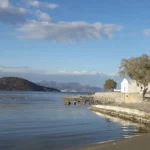
Just 1km east of Istron village lies a hidden gem nestled in a precipitous bay – Pilos beach. Though widely recognized as Istron Bay, in honour of the eponymous hotel perched on the bay’s rugged slopes, the beach is accessible to all through a pathway originating from the west of the hotel. No beaches in Greece are private. Pilos beach is characterized by its sandy stretch and serene blue waters, and offers facilities like umbrellas and a canteen (managed by the hotel) as well as a petite pier for boats.
To the east of Istron Bay, a tiny cove reveals three secluded beaches, reachable via a short walking path. These are known as the Vryonisi beaches, named after the small islet of Vryonisi (or Prasonisi) that appears just opposite the small bay.
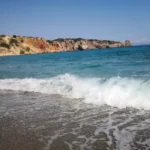
Situated just 10km south of Agios Nikolaos before reaching Istron’s beaches, you’ll discover the lesser-known beach of Vathi. This hidden gem wasn’t on the map before 2010, as it’s a man-made creation and is not visible from the main road connecting Agios Nikolaos with Eastern Crete.
Nestled within a well-protected cove, Vathi remains largely unaffected by wind, except for the infrequent easterly gusts. The beach is characterized by its pristine white sand that enhances the mesmerizing hue of the sea. Managed by the nearby luxury resort, Daios Cove, the beach is well-equipped with amenities.
For non-hotel guests, accessing Vathi involves a descent down a concrete pathway and staircase. To find the entrance, take a left just before the hotel gates and follow the road until it leads to a narrow path heading towards the stairs. Vathi is an excellent choice for families thanks to its calm, waveless waters. For those keen on exploring, snorkelling along the rocky edges of the bay offers another dimension of this unique beach.
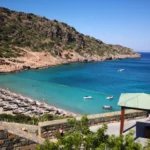
Gournia, situated 17km east of Agios Nikolaos and just 2km west of Pachia Ammos, is renowned for its ancient Minoan town, built atop a small hill. Named after the stone and wooden troughs (‘urna’ in Venetian) found in the vicinity, the original Minoan name of the town remains a mystery.
Nearby, a brief 1km journey north of the archaeological site of Gournia, lies the secluded Frouzis beach. Accessible by car, it sits nestled within a rocky bay, featuring pebbly shores and zero commercial facilities. While the broader area boasts beautiful sea caves and natural rock pools, the beach tends to accumulate litter carried by sea currents. This is also the case for the neighbouring beach, which houses an abandoned camping site.
One of Crete’s most breathtaking natural pools is found near Gournia. This serene rock-bound pond offers an inviting swim, especially when the nearby sea is choppy. The vast cave next to it also provides a fascinating sight.
A trip to Gournia would not be complete without exploring the archaeological site to understand the layout of a small Minoan city. Having thrived in 1500BC, the city has been thoroughly excavated, revealing well-preserved walls, staircases, and streets. The city, centered around a hill housing a small palace, a market, and a temple, appears to have been destroyed by an earthquake around 1450BC, and it was completely abandoned by 1200BC. The Gournia cemetery was discovered in the Sfougaras region, near Kamini.
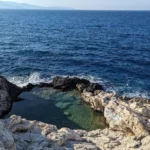
The picturesque Listi Spilios, situated 7km south of Agios Nikolaos along the old road to Sitia and Ierapetra, has become a bustling tourist spot over the years with a variety of accommodations, ranging from large hotels to smaller lodges. The beach is characterized by its rocky terrain and sandy patches, with a charming smaller beach nestled to the north of the main area. Unfortunately, recent extensive alterations by a major hotel in the vicinity have significantly changed the original rocky nature of the coastline, including the construction of a pier to retain sand. Visitors can enjoy amenities like umbrellas, a snack bar, water sports and a beach volleyball court. The quieter western side of the beach, boasting lush vegetation due to nearby freshwater springs, provides a serene escape.
The beach’s intriguing name, Listi Spilios, translates to ‘Robber’s Cave’ in Greek. This stems from a tale from the Middle Ages when the primary road used by locals to commute to island cities ran through this area. On the beach’s west end, there’s a petite peninsula home to several small caves, which, as the legend tells, were used as hideouts by robbers who targeted travellers on the road.
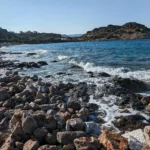
Kamini, situated near the renowned Minoan settlement of Gournia by Pahia Ammos, is an enchanting location composed of five sequential pebble beaches. Positioned north of the archaeological site, Kamini was most likely Gournia’s access point to the sea, explaining the presence of Minoan structures in the area, such as remnants of rooms, walls, and ship sheds or boathouses. The Gournia necropolis is also found in this area.
Kamini’s natural allure is as significant as its archaeological value. The coastline, adorned with limestone conglomerates and strikingly red soil, presents a stunning display of colors. The area boasts intriguing geological formations, sea caves, rock bridges, and five beaches speckled with fine or coarse pebbles. However, some of these beaches can be difficult to access.
Regrettably, the north winds often bring a disheartening amount of trash from across the Aegean Sea, littering the otherwise pristine landscape. This, coupled with the strong winds, tends to deter visitors. However, when the winds shift to the south, Kamini’s true splendor emerges, with turquoise and crystal-clear waters that truly are a sight to behold.
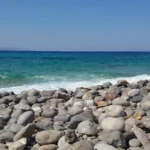
Situated 6km southeast of Agios Nikolaos, along the old route that links Agios Nikolaos to Sitia and Ierapetra, is Ammoudara Beach. This developed area boasts a variety of hotels, rental properties, taverns, and restaurants. There’s a beautiful sandy beach fronting the tourist settlement, with crystal-clear, light-blue waters. Thanks to its eastward orientation, the beach typically enjoys calm seas as the prevalent winds in Crete blow from the west. Beachgoers can enjoy amenities such as umbrellas, sunbeds, and water sports facilities.
Ammoudara provides an ideal setting for family vacations, but the beach’s small size can lead to it feeling somewhat crowded. For those seeking a less populated spot, heading west to the expansive Almiros beach might be a good alternative.

Almyros beach (Almiros) is located 2.5km south of Agios Nikolaos and 12 km from Elounda. It is shaped near the exit of Almiros River, which empties on the south part of the beach. Next to the beach, the protected wetland of Almiros hosts several rare birds, towering eucalyptus trees, reed and some palm trees.
The beach is quite long – 300 m – and very well-organized. It is sandy and the water is shallow and usually calm, making it ideal especially for young children. There are a lot of trees behind the beach, and to the east, you can see the pretty Thrypti Mount. The entrance to the water is very smooth. This beach is suitable for different categories of people, lonely travellers, relaxation getaway lovers, families with children, seniors etc. It is partially crowded during the high season. The area has a few canteens, while there are also many options for water sports. The sea water is very cold in some places due to the river that flows all year round. On the south side of the beach, there are small hotels and apartments.
To reach the beach from Agios Nikolaos city centre, if you do not have a car, you should walk the pedestrian street (5 ‘) which runs along the rocky coasts north of the beach. The pathway starts from Gargadoros beach, which is located 5 minutes south of the town’s marina.
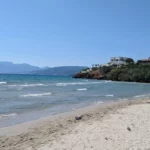
Pachia Ammos is a large village situated on the north side of the narrowest part of Crete, 20km east of Agios Nikolaos, on the road connecting Agios Nikolaos with Sitia and Ierapetra. The village is located at the exit of a fertile plain that is covered with olive groves. It has experienced mild development due to its local beach and the sights of the surrounding area. Visitors can find small hotels, rooms, and taverns in the village.
A long beach with sand and pebbles stretches in front of Pahia Ammos, 500m to the east. The beach is open to the north winds, and the sea is usually wavy. However, visitors can stay safe in the well-protected west part of the beach, which is sandy and clean and has umbrellas and sunbeds. For those seeking peace, the eastern part of the beach is an option, but it is unprotected from the waves, and currents carrying garbage due to the village’s location in the southern part of the Gulf of Mirabello. The beach in this area is pebbly and has several tamarisk trees. At the east end of the beach, a stream flows from the impressive Gorge of Ha in winter.
Pahia Ammos is situated on the site of the ancient city Minoa, which was an old harbour. The Institute for the Study of Prehistoric Aegean of East Crete is established here, which conducts systematic excavations in the area and deals with the promotion and protection of antiquities. The most famous archaeological site in the region is the Minoan cemetery and the settlement of Gournia, which is located 2km west of the village. The city flourished in 1600 BC and was built on a small hill. Gournia is located 2km east of Faneromeni Monastery, one of the most impressive monasteries in Crete built on a steep cliff.
Visitors can also visit the Minoan settlement Vasiliki, which is 4km south of the village and flourished in 2600-2300 BC. Vasiliki is considered the precursor of the major Minoan palaces and towns. From Vasiliki, visitors can drive 2km to the east to reach the village of Monastiraki, with the old watermills and the church of St. Stephen. Nearby is the exit of the imposing gorge of Ha, which causes awe from miles away.
Opposite Pahia Ammos you’ll see the small island Konida (i.e. nit, the egg of louse), which can be reached by boat. It is interesting to see how the place’s name has emerged; a few miles to the east (opposite Tholos) you’ll meet the very important island Psira (i.e. louse), while opposite Mochlos you’ll see the islet of Agios Nikolaos, also called Psilos (flea). All bugs together!

No results available
Reset© All rights reserved. Crete Locals